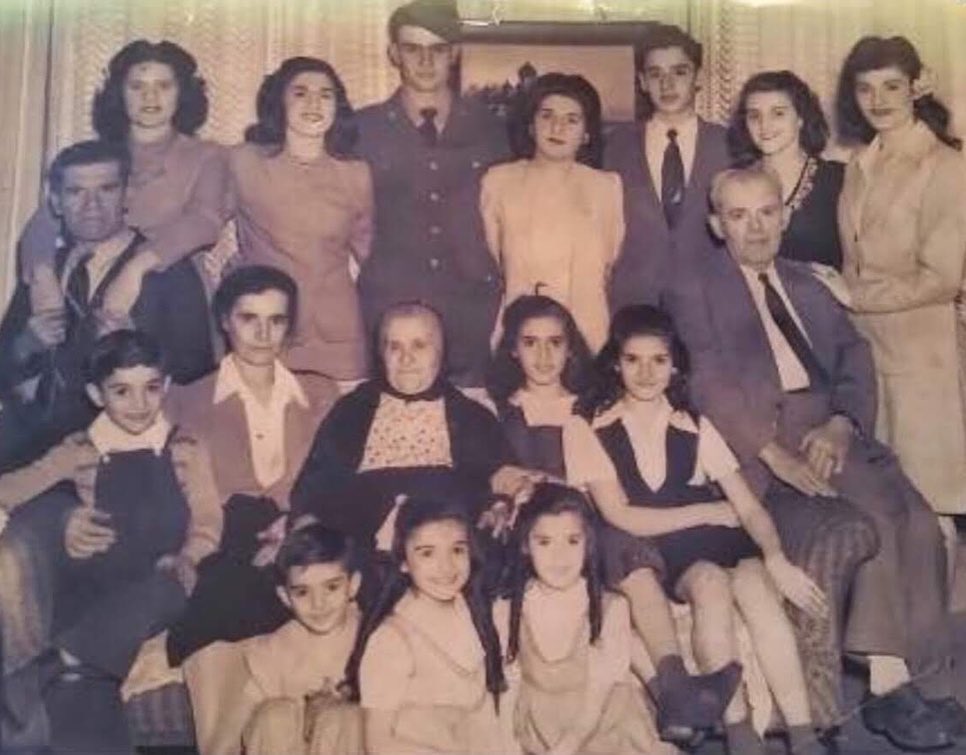Photo: My Lebanese Family, Buffalo, NY, circa 1938. Grandmother, Pauline Haeick, front and center little cutie with her 12 siblings. My Great-Grandmother, Katherine Joseph, and Great-Great Grandmother, Mary Joseph, in the middle row and Great-Grandfather and Great-Great Grandfathers over their shoulders. respectively.
I spend an inordinate amount of time thinking about my ancestry. It’s not that it is particularly interesting (though, my bias believes it to be) but genetics and ancestry in general are just so fascinating. I joked with my family that I may have missed my calling for genealogy – a profession I didn’t even really know existed. The concept that centuries ago, certain dozens of people made decisions – for a whole host of reasons surely – to move. To emigrate. And in those decisions they probably thought, rather hypothetically or abstractly, about the generations of grand children and great grandchildren they’d be affecting. You alway hear people making decisions in order to alter the course of an entire lineage: I do it so my children, and my children’s children and all the way down, will not know the same struggles I’ve endured. And it’s also so fascinating to think about the perfect storm of decisions that had to be made in order for me to exist in the world. I have always thought about them and farther back and I can’t really peg why, but as of late it sent me down a spiral of research and discovery.
I have completed a lot of legwork on Ancestry.com where I’ve developed a family tree which includes 159 people spanning EIGHT generations! That’s wild isn’t it? I also completed Ancestry DNA which was equally exciting.
I have four grandparents and interestingly enough 2 out of 4 were first generation Americans 1 was second generation and 1 was an immigrant, herself:
John Daniel Lenahan – 2nd Generation from (mostly) Irish decent.
(married) Pauline (Therese) Haeick – 1st Generation whose parents were both in Lebanon & Syria.
Frank DeStefano Sr. – 1st Generation whose father was born in Naples, Italy and whose mother’s parents were born in different parts of Basilicata, Italy.
(married) Hilda Gonzalez – She and her mother immigrated to the U.S. from Arecibo, Puerto Rico in about 1946 around the Great Migration of Puerto Ricans to the U.S. (and largely NYC) after they were granted the right to travel to the U.S. without a passport (in 1917) coupled with the Great Depression having a grave impact on Puerto Rico as well as America.
When I first completed my DNA workup I was split relatively evenly between the four descendants. However, as the data pool has grown over the last several months, they’ve changed quite a bit I’m now 37% Italian; 24% Irish; 22% Lebanese/Syrian; and about 17% Puerto Rican [Portuguese/Spanish/Indigenous Puerto Rican]
It has also found familial connections! 1 Close family member: Hi Aunt Loraine! lol; about a dozen second cousins, the majority of which I know and then 32 3rd cousins and even more 4th cousins.
In documents I’ve seen family members hand written draft cards; census reports; marriage and death licenses; newspaper articles; photos; ship/immigrant records, etc. etc. I’ve located specific regions in cities in countries where my ancestors were from and even located addresses. I’ve lined up historical events such as Puerto Rican’s receiving US immigration rights and the Irish Potato Famine which correlate to when ancestors left their countries. I have an Italian grandfather who married a Puerto Rican woman in 1950 and an Irish grandfather who married a Syrian/Lebanese woman around the same time. I can’t imagine what struggles or disapprovals or discrimination they may have faced.
I only have one living grandparent left, and I’m trying to squeeze every last story out of her. Learning that her ancestors all had arranged marriages was interesting but it seemed that when her parents moved to the US they really adopted into the idea of assimilation rather than holding steadfastly to their culture. Same for my Puerto Rican grandmother who didn’t teach her children to speak Spanish because “people look at you differently when you have an accent.”
I think everyone should 1. Keep asking their family questions and learning about them! Oral history is so important to keeping ancestors and history alive. 2. Do some ancestry and DNA work! Even if you’re certain you know your lineage (like I pretty much was) you can still learn so much about your specific genetic makeup, and also more specifics about who came from where and when. Italian is one thing- learning that ancestors were from Naples and Basilicata is a whole other thing.

